- What is insolation?
- Solar Constant
- What is Solar Irradiance?
- Distance from the sun
- The altitude of the sun
- Length of the day
- Methods of Heat Transfer
- Earth's Heat Budget or Energy Budget
- What is Adiabatic Cooling and Heating?
- Why is the lapse rate different for dry and moist air?
- Adiabatic Cooling & Orographic Rain
- Inversion of Temperature
- How does subsidence inversion affect the pollution index?
Earth is a unique planet because it can provide a comfortable habitat for organic life forms. This characteristic of the Earth is because of its atmosphere. Earth’s atmosphere regulates the insolation and maintains an optimum heat budget for its ecosystems. In this article, we will try to understand how Earth maintains such conditions while other planets of our solar system remain hostile to life.
What is insolation?
Insolation refers to the amount of solar radiation that reaches the Earth’s surface. It is the measure of energy received from the sun and is commonly expressed in units of energy per unit area per unit of time (e.g., joules per square meter per hour).
Factors that affect insolation
The following four factors affect insolation:
- Solar constant
- Distance from the sun
- The altitude of the sun
- Length of the day
Solar Constant
“Is the intensity of solar radiation or insolation received perpendicularly on a unit area at the average distance from the sun.”
Or
“The Solar constant is defined as the irradiance received by the Earth when the sun’s rays hit the surface of the Earth perpendicularly. It is measured at a distance of one astronomical unit, which is approximately the distance between the sun and the Earth.”
The average value of the solar constant is…
2 gram calories per square centimeter per minute
Distance from the sun

Kepler’s Law governs the motion of all planets. This is why we know that the orbit of Earth around the sun is elliptical. Hence, our planet doesn’t rotate around the sun at an equal distance or at an equal time. Earth moves at a faster pace when it is closest to the sun, and this distance is called the Perihelion. Similarly, it moves at a slower pace when it is farthest from the sun, and this distance is known as Aphelion. This movement of Earth affects the insolation it receives.

The average distance from the sun is 1 AU. Since the orbit is elliptical, Earth is at this distance on April 4th and October 5th.

What are Perigee and Apogee?
These are the closest and farthest points of the moon from the Earth in its elliptical orbit around the Earth.
The altitude of the sun

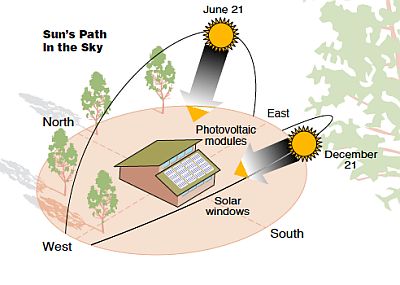
The angle at which the sun’s rays fall affects insolation as well. The altitude of the sun refers to the angle at which the sun’s rays form when they touch the Earth’s surface. The altitude of the sun keeps changing throughout the day. At sunrise and sunset, the altitude is the lowest, i.e. the rays make the lowest angle with the surface and transfer the least amount of heat. During midday, the sun is at its highest altitude and transfers the maximum heat. Similarly, at different latitudes, the rays of the sun fall at different angles. At higher latitudes, the sun’s rays are slanting, while at lower latitudes they are much more vertical.

As shown in the figure, the increase in the area that the rays have to cover changes the solar constant of the region. Also, when the sun’s rays are slanting, the reflectance increases, resulting in a further reduced absorption rate.
What is albedo?
Albedo refers to the fraction of light that a surface reflects back. It is the ratio of light reflected to the amount of light that hits a surface.
Albedo is typically expressed as a percentage, with values ranging from 0 to 100%. A surface with an albedo of 0% would absorb all the light that hits it, while a surface with an albedo of 100% would reflect all the light that hits it.
Albedo is an important factor in climate science, as it affects the amount of solar radiation or insolation that is absorbed or reflected by the Earth’s surface. Surfaces with a high albedo, such as snow and ice, reflect a large amount of solar radiation, while surfaces with low albedo, such as dark soil or water, absorb more solar radiation. This can have a significant impact on the Earth’s temperature and climate.
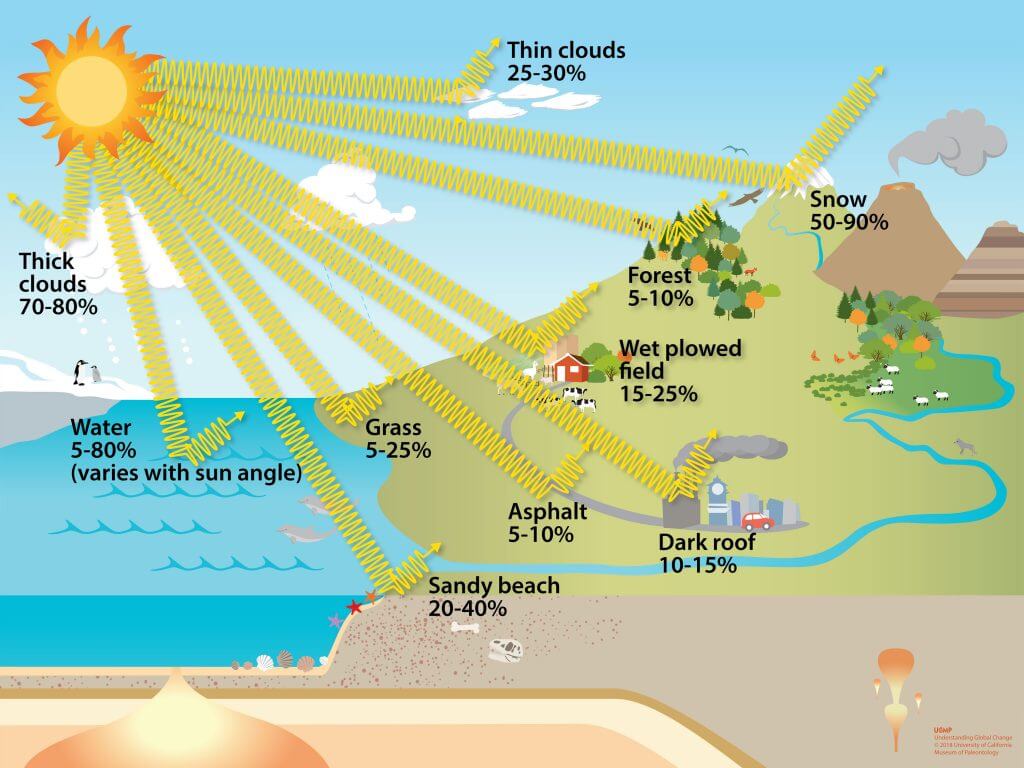
Length of the day
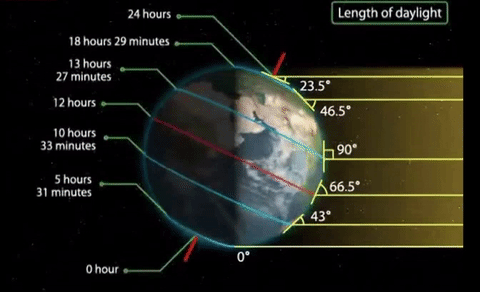
The length of the day varies as we travel from one latitude to another. This happens because of the movement and tilt of the Earth.
The tilt of the Earth forms a circle of illumination. Due to this, the sun’s rays are prolonged at some places on the summer solstice while those on the winter solstice receive less insolation.
| Latitude | 0° | 20° | 40° | 60° | 90° |
| December 22 | 12:00 | 10:48 | 09:8 | 05:33 | 00:00 |
| June 21 | 12:00 | 13:12 | 14:52 | 18:27 | 6 months |
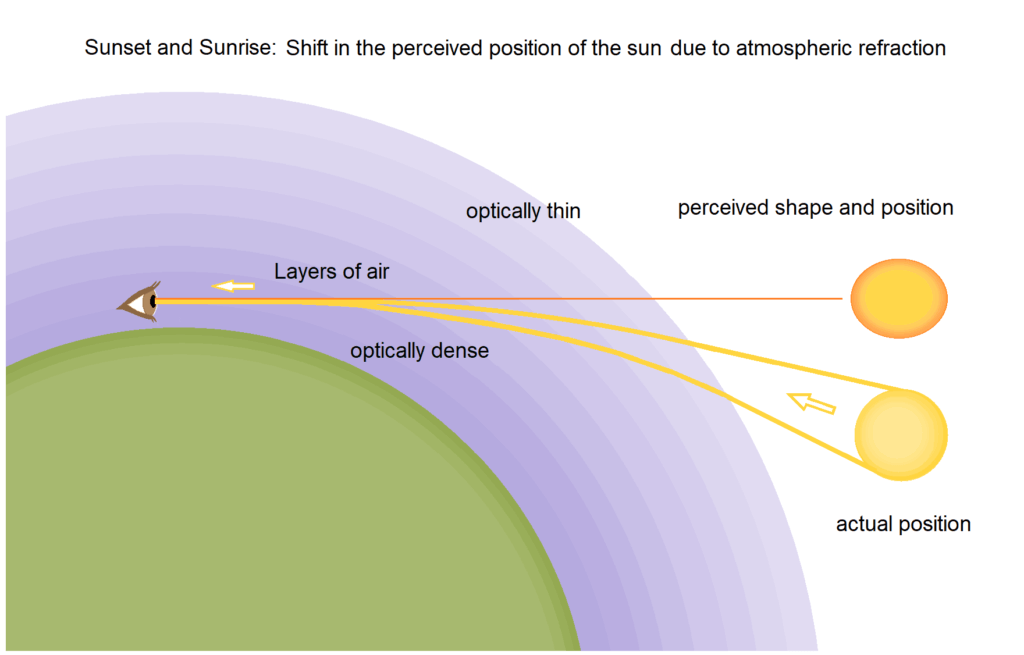
Why are days always longer than nights at the equator?
Answer: Because the atmosphere refracts the Sun’s rays.
When the rays of the sun enter the atmosphere from space, they enter a denser medium (space to atmosphere), which makes them refract. Hence, we see the sun before it rises and even after it sets. This is known as an advanced sunrise and a delayed sunset.
Methods of Heat Transfer
The Earth receives most of its energy from the sun in the form of insolation, which is a type of electromagnetic radiation. This energy travels through empty space and reaches the Earth. Insolation can be classified into two types based on its wavelength: short-wave radiation and long-wave radiation. When the energy from the sun travels through the atmosphere and reaches the Earth, it is in the form of short-wave radiation. However, when the Earth radiates the energy back into space, it is in the form of long-wave radiation.
Because energy transfer occurs through different wavelengths, it requires different processes. Energy transfer between objects can occur through three methods: conduction, convection, and radiation.


Conduction
Conduction is the method of heat transfer in solid objects. Usually, metals are better conductors. In a solid medium, heat is transferred when atoms and molecules rub against each other and transfer their energy to the neighbouring atoms.
Convection

Convection occurs in fluids (liquids and gases). When one layer of fluid receives the energy, it expands and becomes lighter and moves upward. This causes circulation in fluids, enabling heat transfer.
Radiation
Radiation transfers heat through electromagnetic waves. This means, unlike conduction and convection, heat can be transferred even without any medium. Energy from the sun reaches the Earth through shortwave radiation.
Insolation or radiation reaches the Earth as short waves, but in maintaining Earth’s heat budget, conduction and convection play a minor role in energy transfer, while radiation is the dominant process. This is because the Earth is surrounded by a vacuum, so conduction and convection are not effective methods of transferring energy. Instead, the majority of energy transfer occurs through radiation. The Earth absorbs the short-wave radiation from the sun and re-emits it as long-wave radiation, which is absorbed by greenhouse gases in the atmosphere, such as carbon dioxide and water vapour. These gases trap some of the heat, which helps to keep the planet warm.
Convection Vs Advection
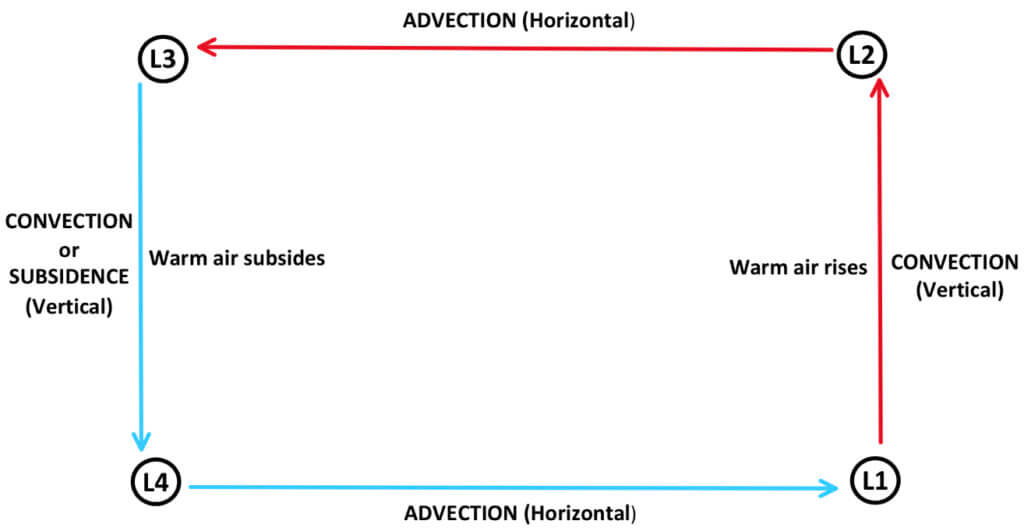
When insolation reaches the Earth, it encounters fluid (air or water). When this fluid is heated, it moves or rises up. This vertical movement of air due to temperature variation is known as convection. In the figure, the movement of air from L1 to L2 and from L3 to L4 is convection. When air moves vertically downwards, it is known as subsidence (L3 to L4).
The horizontal movement of air from L4 to L1 and from L2 to L3 is known as advection. In advection, mass transport of air takes place from one area to another due to temperature variation.
The Earth’s heat budget, also known as the energy budget, is the balance between the amount of energy the Earth receives from the sun and the amount it radiates back into space. This balance plays a critical role in determining the planet’s overall temperature and climate.
Most of the energy that enters the Earth’s atmosphere comes from the sun in the form of visible light, ultraviolet radiation, and other types of short-wave electromagnetic radiation. Some of this energy is reflected back into space by clouds, the Earth’s surface, and other reflective surfaces.
The remaining energy is absorbed by the Earth’s surface and atmosphere and converted into long-wave radiation. This long-wave radiation, also called infrared radiation or “heat radiation,” is then radiated back into space. However, some of this infrared radiation is absorbed by greenhouse gases in the atmosphere, which helps to keep the planet warm.
Earth’s Heat Budget or Energy Budget
The heat budget, also known as the energy budget, refers to the balance between the amount of energy (insolation) that enters the Earth’s atmosphere from the sun and the amount of energy that is radiated back into space. This balance between the incoming insolation minus the reflected and outgoing long-wave radiation determines the overall temperature and climate of the planet.
The sun is the primary source of energy for the Earth’s heat budget, providing most of the energy that enters the Earth’s atmosphere in the form of visible light, ultraviolet radiation, and other types of short-wave electromagnetic radiation. Some of this energy is reflected back into space by clouds, the Earth’s surface, and other reflective surfaces. The rest of the incoming energy is absorbed by the Earth’s surface and atmosphere, where it is converted into long-wave radiation. This long-wave radiation is then radiated back into space in the form of infrared radiation, some of which is absorbed by greenhouse gases in the atmosphere, helping keep the planet warm even at night. The balance of these processes ultimately determines the overall temperature and climate of the Earth. The figure below shows the total heat budget of our planet.
What is Adiabatic Cooling and Heating?

People generally know that heat transfer is the method used to cool or heat things, but the temperature of a fluid can also change when its volume changes. If pressure is applied to a parcel of air, its temperature will rise as the size of the parcel decreases, and conversely, its temperature will decrease when pressure is reduced. This process is called adiabatic cooling or adiabatic heating.
Adiabatic cooling and heating happen without any heat transfer. However, pressure is created because of heat transfer caused by insolation, and there is no movement without heat transfer.
Adiabatic Lapse Rate
Lapse rate
Now we know that rising air expands and cools adiabatically, but at what rate does it cool?
The rate of change of temperature with height is highly variable and depends on many factors like temperature, humidity, etc., but its average value is 6.5 °C per kilometre or 18.8 °F per mile.
Dry-adiabatic lapse rate
Rising air cools much faster when it is dry or unsaturated. The rate at which it cools is 10 °C per kilometre.
Moist-adiabatic lapse rate
Rising moist or saturated air cools at 6 °C per kilometre.
Why is the lapse rate different for dry and moist air?
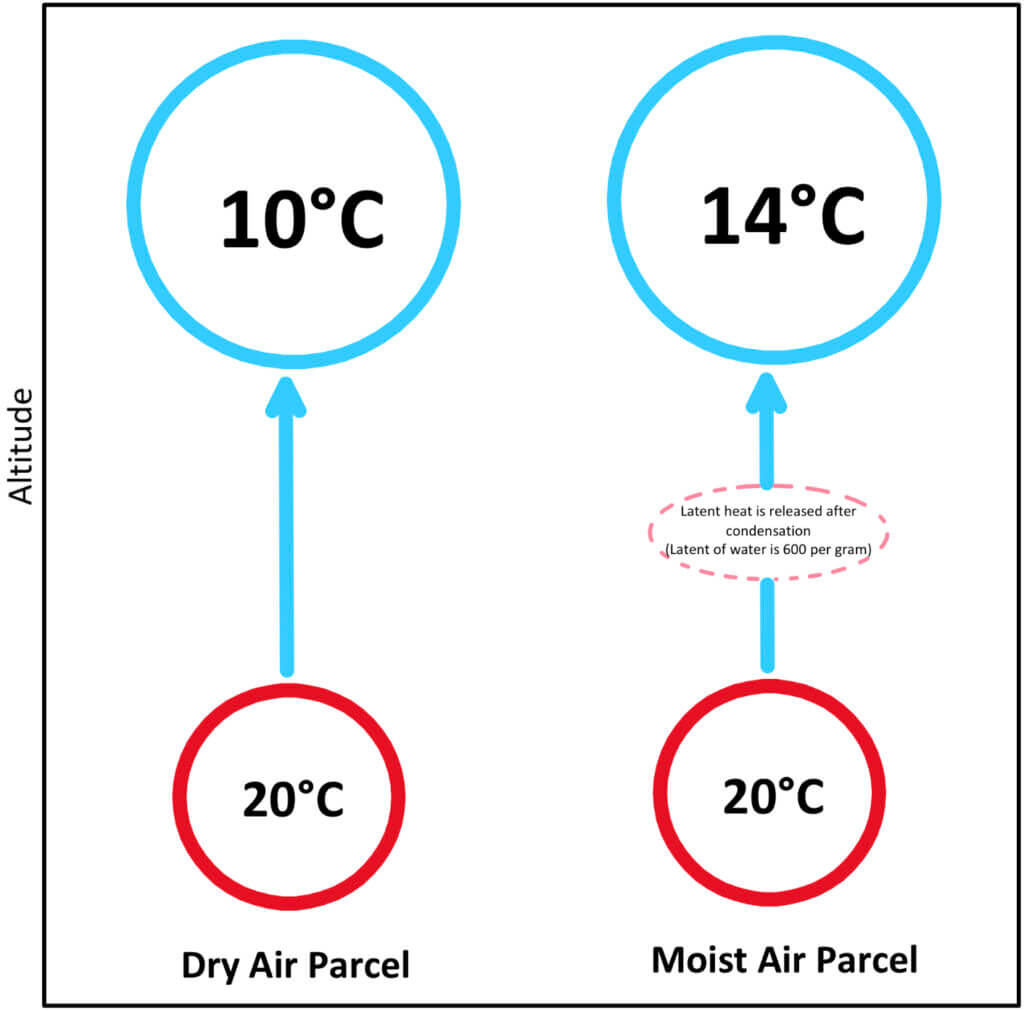
This is because of the latent heat of the moisture. Moist air condenses and forms droplets when it rises and experiences a decrease in temperature. Moist air condenses and forms droplets when it rises and experiences a decrease in temperature. Whereas in dry air, there is no latent heat, and its temperature drops more rapidly.
Adiabatic Cooling & Orographic Rain
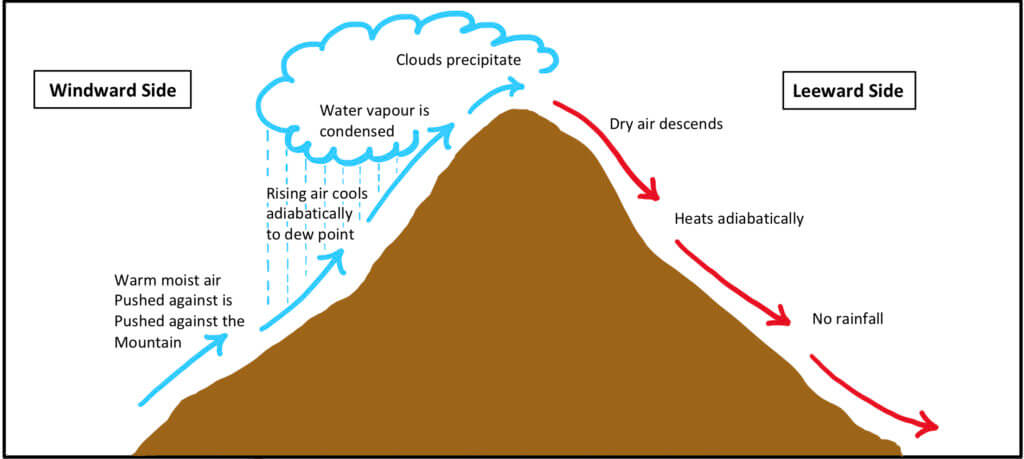
Inversion of Temperature
When we move up to higher altitudes, the temperature falls at a rate of 6.5 °C per kilometre or 18.8 °F per mile in the troposphere. However, sometimes there are some anomalies, and instead of falling, there is a rise in the temperature as we move up. This condition is known as the inversion of temperature.
Inversion of temperature is an anomaly in the vertical distribution of temperature when temperature increases with an increase in altitude.
There are five types of inversion of temperature:
- Radiation Inversion
- Drainage Inversion
- Frontal Inversion
- Advection Inversion
- Subsidence Inversion
Radiation Inversion
Earth’s surface loses more heat by radiation at night. In the clear night sky or at higher latitudes, the air above the surface is cooled, while at higher altitudes it might still be warm. This type of inversion happens on a clear night and over flat plains and results in fog.

Drainage Inversion
This happens in the valley regions when the heat in the valley escapes in the form of longwave radiation. Cold air from the higher land falls or drains into the valleys and causes an inversion of temperature.

Frontal Inversion
When the cold and warm air masses push against each other, they form a front, and the air doesn’t readily mix. The warm air mass is lifted as it is lighter than the cold air mass. This results in an inversion of temperature.

Advection Inversion
When a warm parcel of air is transported over a cold surface of land, water, or snow, it is cooled through conduction from below. This causes an inversion of temperature as the upper layers are still warm while the lower layer has cooled.

Subsidence Inversion
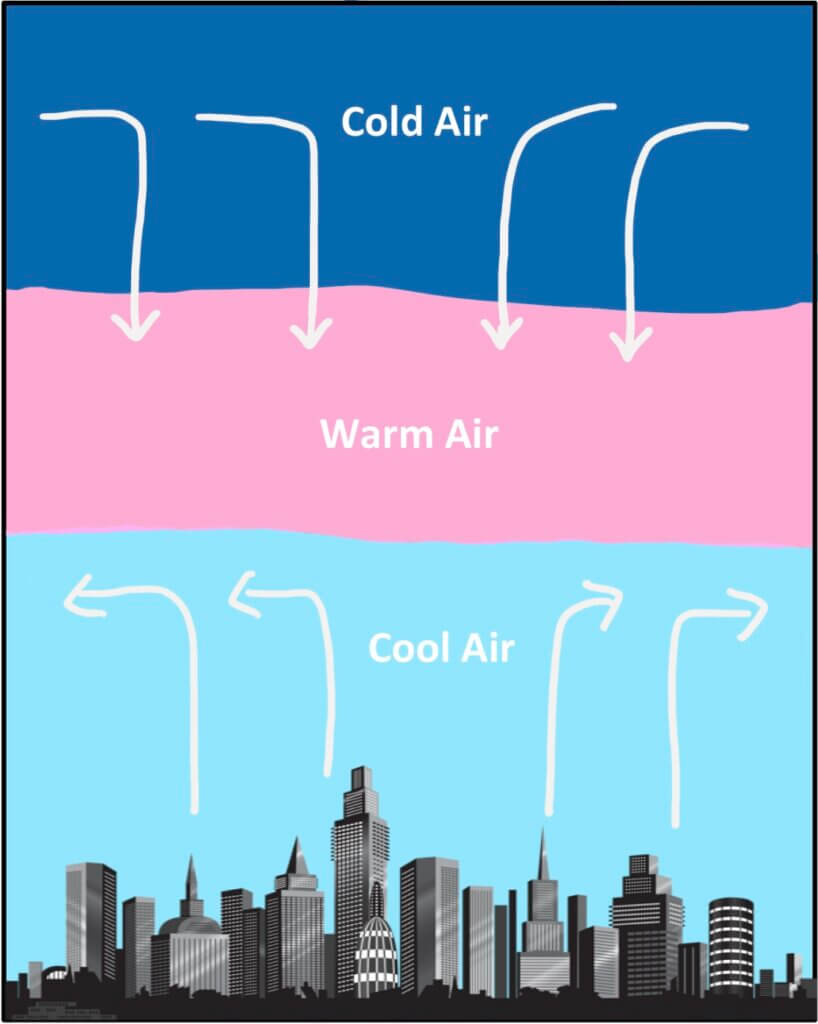
Occurs in regions of high pressure, where the air in mass subsides. This vertical subsidence of air causes compression and adiabatic heating of air. The subsiding air mass compresses the layer below it while air near the surface is still cool. So with a rise in altitude, the air near the surface will be cool, and the air above will be warm.
How does subsidence inversion affect the pollution index?
